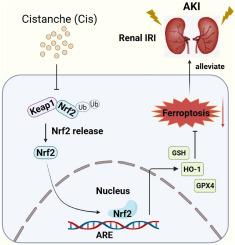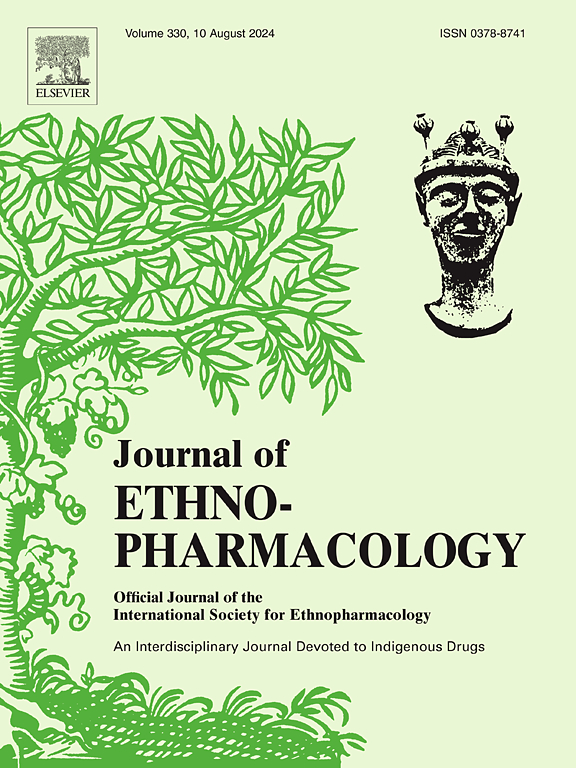Cistanche attenuates acute kidney injury by inhibiting ferroptosis through the disruption of Keap1-Nrf2 interaction
IF 5.4
2区 医学
Q1 CHEMISTRY, MEDICINAL
引用次数: 0
Abstract
Ethnopharmacological relevance
Ferroptosis, an iron-dependent regulated cell death, critically contributes to acute kidney injury (AKI) progression. Emerging evidence suggests ferroptosis inhibition as a therapeutic strategy against AKI. Cistanche (Cis), a kidney-tonifying herb in traditional Chinese medicine, exhibits antioxidant activity via nuclear factor erythroid 2-related factor 2 (Nrf2) activation. However, the precise molecular mechanism underlying cistanche-mediated Nrf2 activation remains undefined, and its nephroprotective potential in AKI is incompletely characterized.
Aim of the study
To investigate the renoprotective effects of cistanche against AKI and elucidate its mechanism through the Keap1-Nrf2-ferroptosis axis.
Materials and methods
An ischemia-reperfusion injury (IRI)-induced AKI mouse model and a hypoxia-reoxygenation-induced mRTEC cell model were constructed to evaluate the protective effects of cistanche. First, cistanche (2.055, 4.110 and 8.220 g/kg), and saline were administered for 6 days. On the 5th day, the mice were anesthetized and then bilateral renal artery clamping was performed for 45 min. Mice in the sham-operated group underwent the same operation but no arterial clamping was performed. Until 24 h after the IRI procedure, all mice were anesthetized, then blood samples and kidney tissue were collected. Subsequently, Nrf2 knockout mRTEC cells were used to verify whether Nrf2 mediated the nephroprotective effects of cistanche. Furthermore, the effect of cistanche on Keap1-Nrf2 protein-protein interaction (PPI) in the kidney of IRI mice was verified by CO-IP assay. Finally, UPLC-Q-TOF/MS technique and molecular docking were utilized to analyze the potential pharmacological components of cistanche.
Results
In vivo, cistanche treatment improved renal function in IRI mice, as shown by decreased serum creatinine (SCr), blood urea nitrogen (BUN), inflammatory factors, and renal injury markers (NGAL, KIM-1), along with ameliorated ferroptosis-related abnormalities. In vitro, cistanche suppressed ferroptosis in hypoxia-reoxygenation-induced HK2 cells by activating Nrf2, an effect that was significantly diminished upon Nrf2 silencing in mRTEC cells. Mechanistically, cistanche facilitated Nrf2 nuclear translocation and inhibited ferroptosis, likely by disrupting the Keap1-Nrf2 protein-protein interaction. Furthermore, UPLC-Q/TOF-MS analysis identified key bioactive components in cistanche that may contribute to its anti-ferroptosis effects.
Conclusion
Overall, cistanche functions as a putative Keap1-Nrf2 PPI inhibitor primarily through its phenylethanoid glycosides. By disrupting Keap1-Nrf2 binding, it activates Nrf2 signaling, suppresses ferroptosis, and confers protection against AKI, positioning it as a promising therapeutic candidate.

肉苁梗通过破坏Keap1-Nrf2相互作用抑制铁下垂,从而减轻急性肾损伤。
民族药理学相关性:铁中毒是一种铁依赖性调节细胞死亡,对急性肾损伤(AKI)的进展有重要影响。新出现的证据表明,抑制铁下垂可作为抗AKI的治疗策略。肉苁蓉(Cis)是一种补肾中药,其抗氧化活性是通过激活核因子红细胞2相关因子2 (Nrf2)来实现的。然而,肉糜酸介导的Nrf2激活的确切分子机制仍然不清楚,其在AKI中的肾保护潜力也不完全确定。目的:通过Keap1-Nrf2-ferroptosis轴探讨肉苁梗对AKI的肾保护作用及其机制。材料与方法:建立缺血再灌注损伤(IRI)诱导的AKI小鼠模型和缺氧再氧化诱导的mRTEC细胞模型,评价肉苁苁醇的保护作用。首先给予肉糜(2.055、4.110和8.220 g/kg)和生理盐水6 d。第5天,麻醉小鼠后夹持双侧肾动脉45 min。假手术组小鼠进行相同的手术,但不进行动脉夹持。IRI手术后24小时,所有小鼠麻醉,然后采集血液和肾脏组织。随后,使用Nrf2敲除的mRTEC细胞来验证Nrf2是否介导肉苁茸的肾保护作用。此外,通过CO-IP法验证肉苁酱对IRI小鼠肾脏Keap1-Nrf2蛋白相互作用(PPI)的影响。最后利用UPLC-Q-TOF/MS技术和分子对接技术对肉苁蓉的潜在药理成分进行分析。结果:在体内,肉苁苁醇治疗改善了IRI小鼠的肾功能,表现为血清肌酐(SCr)、血尿素氮(BUN)、炎症因子和肾损伤标志物(NGAL、KIM-1)的降低,以及铁中毒相关异常的改善。在体外,肉苁梗通过激活Nrf2抑制缺氧再氧化诱导的HK2细胞中的铁凋亡,而在mRTEC细胞中Nrf2沉默后,这种作用显著减弱。从机制上讲,肉苁酱可能通过破坏Keap1-Nrf2蛋白的相互作用,促进了Nrf2核易位并抑制了铁凋亡。此外,UPLC-Q/TOF-MS分析鉴定了肉苁茸中可能有助于其抗铁下垂作用的关键生物活性成分。结论:总体而言,肉苁蓉作为一种推定的Keap1-Nrf2 PPI抑制剂主要通过其苯乙醇苷发挥作用。通过破坏Keap1-Nrf2结合,它激活Nrf2信号,抑制铁下垂,并赋予对AKI的保护,使其成为一种有前途的治疗候选药物。
本文章由计算机程序翻译,如有差异,请以英文原文为准。
求助全文
约1分钟内获得全文
求助全文
来源期刊

Journal of ethnopharmacology
医学-全科医学与补充医学
CiteScore
10.30
自引率
5.60%
发文量
967
审稿时长
77 days
期刊介绍:
The Journal of Ethnopharmacology is dedicated to the exchange of information and understandings about people''s use of plants, fungi, animals, microorganisms and minerals and their biological and pharmacological effects based on the principles established through international conventions. Early people confronted with illness and disease, discovered a wealth of useful therapeutic agents in the plant and animal kingdoms. The empirical knowledge of these medicinal substances and their toxic potential was passed on by oral tradition and sometimes recorded in herbals and other texts on materia medica. Many valuable drugs of today (e.g., atropine, ephedrine, tubocurarine, digoxin, reserpine) came into use through the study of indigenous remedies. Chemists continue to use plant-derived drugs (e.g., morphine, taxol, physostigmine, quinidine, emetine) as prototypes in their attempts to develop more effective and less toxic medicinals.
 求助内容:
求助内容: 应助结果提醒方式:
应助结果提醒方式:


